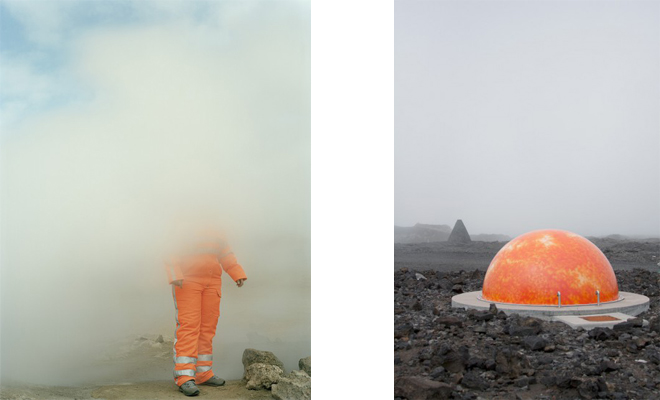Art Fly: Judy Natal Lecture
Last week, resident art fly Rachel Gorman attended a lecture by photographer Judy Natal at the Joan Mitchell Center. This week, she reflects on the experience and speaking the language of art.

Judy Natal, Future Perfect: Steam Portrait Emergency Worker (left) and Future Perfect: Sun in Fog (right), both 2008-2012. Archival inkjet prints. Courtesy the artist.
Okay, full disclosure, readers: I’m not exactly an ivory-tower-trained art critic. My current credentials include my life-long love of the art world and a willingness to express my opinions—for better or for worse. These columns are a mixed product of my belief in democratizing conversations about art and, let’s face it, hubris.
I say that outright this week not to shock you (something tells me my past posts on the state of wine consumption at gallery events haven’t exactly read “academic”) but because I realize a mission to approach art as a layperson can become an intellectual crutch. It’s easy to conflate maintaining an accessible, fresh perspective with an excuse to be (at best) purposefully naïve and (at worst) pretty lazy. It’s a short trip to believing that “art is for everybody” actually means that I, or any amateur art appreciator, should never be asked to do more than show up. That it’s the art world’s responsibility to accommodate its audience (the excuse says), not ask them to learn its language. No one should feel excluded or scared away from art by a failure to understand it.
The truth is, that while art conversations have a responsibility to be inclusive, that doesn’t necessarily mean they will always be easy to understand. There are works that deal with ideas bigger and more complex than can be distilled into the plainest language, that require an awareness of what came before them. Being wrenched out of your comfort zone, presented with a higher-level discourse than what you’re used to, and then asked to rise to the occasion isn’t fun. No one likes a challenge that reminds them of their limitations, but learning to speak art’s language can be an important part of deepening your appreciation for it. No pain, no gain. I can say that confidently, readers, because last week I was in a world of hurt.
Wednesday night, I attended Chicago-based artist Judy Natal’s discussion Photography That Thinks, Acts, and Sees: Social Engagement and the Shifting Sands of Photographic Practice. Before a seated audience of about 25, Natal led a conversation about her work, the history of documentary-style photography, and the distinction between photographers who make art for art’s sake, those who identify as “socially engaged,” and those who more ambitiously describe themselves as “activists.”
I should say here that if I could choose any artist-lecturer to illustrate the difference between an art conversation being inclusive and being easy, Natal would top my list. Her professional background as a professor at Columbia College and a photographer who values collaboration was readily apparent. In her opening remarks, Natal asked the audience to settle in, get casual, and grab some coffee. She praised New Orleans for its “sense of activism, community, and dialogue” and stressed that she was not here to speak as an expert. She wanted to present “more questions than answers.” She was humble, inviting, and about to kick my intellectual butt.
The first portion of Natal’s lecture centered on her own artistic practice—how she began to self-identify as an activist artist who doesn’t just create art for the sake of expression or to showcase global issues as a concerned but passive bystander. Instead, Natal’s art as she describes it encapsulates more, actively agitating for solutions to the problems it presents. Natal showcased images from Future Perfect, her series currently on view at The Front, with works like her Steam Portraits that as she describes them, “imagine future landscapes as a way to shed light on current environmental choices.” The portraits present their subjects enveloped, partially, or wholly obscured in the steam rising from an otherwise barren Icelandic landscape. They did show a plain departure from the “concerned witness” photography of the early and mid twentieth century, but I found myself hard pressed to explain how.
I was still grappling with the distinction when Natal’s discussion picked up speed. She continued to talk through an abridged history of photography and its academic definitions in an informal way, but as the lecture wore on I increasingly found myself furiously writing lists of terminology and names that may have been casual for her, but were unfamiliar to me. Despite Natal’s best effort to keep her scholarly discussion inviting, as her references and language got more esoteric, the conversation became predictably more exclusive. I felt lost in a sea of references—modernism then pluralism, Ai Weiwei then David Buckland—holding on to the ones I recognized like they were floating debris.
When the floor was opened for conversation among attendees, to my surprise, it rarely lagged. Many in the room, it turned out, were more fluent in this language than I was. My marginalization felt worse than ever, but I realized as the event came to a close that really, it wasn’t a bad thing—simply a reminder to hit the books a little harder. Natal asked attendees to weigh in on her artistic process without sacrificing the complexity or sanctity of her ideas. I may not have grasped the finer points of the subject at hand, but the night reminded me of a lesson perhaps more important: democratizing a conversation about art doesn’t mean dumbing it down.
Editor's Note
"Future Perfect" on view through February 3 at The Front (4100 St. Claude Avenue) in New Orleans.



